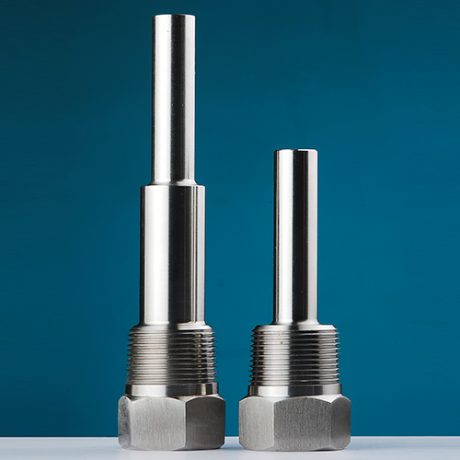Description
Typical Application:
1. Effectively cover and guard the temperature sensing elements from the high pressure, flow and other detrimental properties of the processes into which they are inserted.
2. Thermowells isolates the temperature sensors like thermocouples and RTDs, and they can be safely applied (without any insulation) for measuring the temperature of a process which can be either in the form of liquid or gas.
3. They enable the removal and replacement of temperature sensor from the process without making any compromise with the process and ambient surroundings.
Types of Thermowells:
The most widely used thermowell designs depending upon their process connections are classified below:
- Threaded
- Socket weld
- Flanged welded
A threaded thermowell is screwed into the process. A socket weld thermowell is welded into a weldalet and a weld in thermowell is welded directly into the process. A flanged thermowell has a flange joined to a thermowell stem most commonly by a welding process.
The most widely available thermowell shank designs include:
- Straight shank Thermowell: It maintains the same size throughout the entire thermowell immersion length. Straight wells are specified where increased life is desired due to corrosion or erosion
- Step shank Thermowell:Stepped, sometimes referred to as reduced tip, wells are usually ¾” diameter and step down to ½” diameter to improve time response. Tapered wells are a balance between strength and time response.
- Tapered Thermowell:Its outer diameter is gradually and steadily reduced over the thermowell immersion length. In general, a heavy duty tapered shank thermowell finds its use in applications involving high vibrations, pressure, temperature and velocity.
Connections to the process are accomplished with tapered pipe threads or adaptations of pipe or sanitary tubing flange connections. A blank or blind flange is modified to accept the thermowell stem and then easily attaches to standard flanges
Weld‐in styles are used for convenience or where exposed threads may collect contaminants such as in food processing or pharmaceutical production.
Testing:
Each thermowell is factory tested with nitrogen gas at 1000psig (69 Bar).
Other optional tests like hydro-test (1.5 times of the working pressure), PMI, LPI are available upon request.
Materials of Construction:
Different base materials like Carbon steel, SS 304, SS 316, SS 316L, Inconel, Monel, Hastelloy are available based on the process requirements and applications.
Selection Criteria:
As a minimum, following points must be considered while selecting a thermowell for a particular application:
- Immersion Length:The immersion (U) length of a thermowell plays significant role in deciding the accuracy of temperature measurements. In general, “U” length of a thermowell is limited to five times the thermowell’s external diameter for getting accurate results. This is the immersion length maintained in case of processes involving liquids whereas in case of gas or air associated processes, the required minimum U length is set to at least ten times the external diameter of the thermowell.
- Vibration Resistance:The Performance of thermowells gets adversely affected by turbulent vibrations. These vibrations are created by gas or liquid flowing in the process area which is subjected to temperature measurement. The intensity of these vibrations depends upon the thermowell’s diameter and the liquid (or gas) flow. To prevent or reduce the occurrence of these vibrations, thermowells must be designed with robustness. Most preferred type of thermowell design which can stand against vibrations is the tapered thermowell design since it offers excellent performance without even compromising the temperature sensitivity of a thermowell.
- Material of Construction:Appropriate material must be chosen for durable and effective results. In case the thermowell is made up of incompatible material, there will always be risk of thermowell failure. Hence, thermowell must always be chosen keeping in view the process temperature along with the corrosion and erosive conditions of the process.


Reviews
There are no reviews yet.